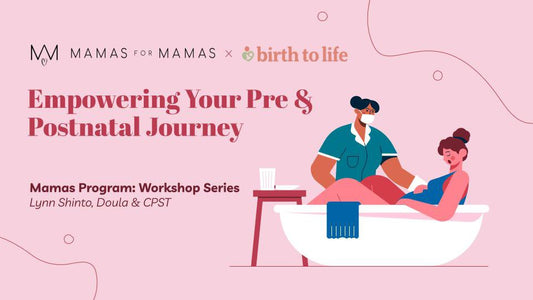The Essential Elements of a Birth Plan
As a birth and postpartum doula, I am passionate about supporting families and helping them create personalized and empowering birth experiences.
Today, I want to discuss what to include in a birth plan template (or what I like to call, a birth preferences list or roadmap, as birth is dynamic and best to remain flexible on options), which can serve as a blueprint for your labour and delivery preferences. Remember, every birth is unique, and your birth plan should reflect your individual needs and desires.

Understanding the Purpose of a Birth Plan
A birth plan is not a rigid contract, but rather a flexible tool that allows you to communicate your preferences, wishes, and goals to your healthcare providers. It serves as a guide for your birth team to better understand your vision for your labour and delivery in a hospital birth setting. While it is important to remember that birth can be unpredictable, having a plan in place can help you feel more in control and confident as you navigate the birthing process.
Flexibility: Embracing the Unexpected
Flexibility is key when creating a birth plan. Understand that your obstetrician or certified nurse midwife will be monitoring your progress and making recommendations to ensure the safety and comfort of both you and your baby. Remaining open to adjustments during delivery, including different birthing positions, will help create the best possible outcome. Remember, your birth plan is a starting point, and changes may be necessary to prioritize your well-being and your baby's health.
Pain Management: Your Choices Matter
Pain management during labour is a personal decision. Take the time to explore your options and consider what will work best for you. Some birthing parents prefer unmedicated childbirth, while others opt for pain medication such as an epidural, or other options such as nitrous oxide (laughing gas), TENS machine, etc. Within your birth plan, you can include instructions regarding your preferences for pain relief, such as whether you would like pain medication offered or if you prefer to request it when needed. If you're considering a c-section birth plan, it's important to know that you can change your mind during labour and adjust your pain management plan accordingly.

Selecting Your Support System
Choosing your support people during labour is an important decision. Whether it's your partner, a family member, a doula, or your midwife/OB/family doctor, having someone by your side who understands your desires and can advocate for you is invaluable. Communicate your preferences for who you want present during labour and delivery, ensuring that you create an environment that fosters a sense of safety, comfort, and empowerment.
Postpartum Care: Tailoring Your Experience
Considering your preferences for postpartum recovery and newborn care is an essential part of your birth plan. Reflect on aspects such as whether you want your support person to be involved in cutting the cord, if you desire help with breastfeeding, and whether you want your baby to receive a pacifier. Emphasize your desire for immediate skin-to-skin contact and uninterrupted bonding time with your newborn. Remember, your birth plan extends beyond labour and delivery to encompass the moments after your baby's arrival.
Privacy: Creating an Intimate Space
Privacy is crucial during the birth and birthing process. It allows you to focus inward, tapping into your inner strength and intuition. Requesting a private and sacred space enables you to fully immerse yourself in the birthing process and maintain a sense of calm and concentration. Communicate your wishes for privacy within the birthing space, whether it's by limiting the number of people present or using signage to indicate your need for solitude.
Embracing Darkness: Setting the Mood
Creating a dimly lit environment can enhance the birthing experience. Darkness promotes relaxation and intimacy, allowing your senses to focus on the shifts and changes within your body during birth. Consider using dimmer lights, closing curtains or blinds, or even bringing battery-operated candles or fairy lights to create a cozy and serene atmosphere. By embracing darkness, you create an ambiance that encourages the release of oxytocin, the hormone responsible for labour progression.

Warmth: Nurturing Your Body
Maintaining warmth during the birthing process is essential for comfort and relaxation. When we feel cold, our muscles tense up, hindering the progress of birth. Ensure that you have access to blankets, robes, and warm clothing to create a cozy nest around you. Utilize warm water, such as taking a soothing bath or shower, to ease discomfort. By nurturing your body with warmth, you encourage the free flow of blood and promote relaxation, making it easier for your baby to be born.
Silence: Cultivating Calmness
In the midst of the birthing process, a calm and quiet environment can foster a focused and serene mindset. Excessive noise can disrupt your concentration and interrupt the flow of birth. Request that those present in the birthing space maintain quiet and gentle voices. Consider using signage to remind others to be mindful of noise levels. By cultivating silence, you create a tranquil atmosphere that allows you to connect with your body and baby on a deeper level.
The Power of the 5 Essential Elements
The five essential elements of a birth plan—safety, privacy, darkness, warmth, and silence—work together to create an optimal environment for a smooth and positive birthing experience. When these elements are prioritized, they support the flow of oxytocin, facilitate relaxation, and allow your body to work harmoniously during labour. Remember, your birth plan should reflect your unique needs and desires, empowering you to advocate for the birth experience you envision and your wishes for a safe delivery.
Discussing Your Birth Plan
Engaging in open and honest conversations with your healthcare provider is crucial when creating your birth plan. Schedule a discussion with your OB-GYN or certified nurse midwife around 32 weeks of pregnancy to review and fine-tune your plan for a hospital birth. Share your preferences, ask questions, and ensure that your healthcare provider understands your vision. By collaborating with your provider, you can align on a birth plan checklist that supports your goals while considering any hospital or birth center policies.
Embracing the Unexpected: Trusting Your Journey
While a birth plan helps set the stage for your ideal birth experience, it's important to embrace the unexpected. Birth is a transformative and unpredictable process, and it's essential to trust your body and the journey it takes. Focus on self-care practices such as healthy eating, regular exercise, meditation, and envisioning a positive birth experience. Remember that even if your birth plan changes, your healthcare providers will be there to support you and ensure the safety of you and your baby, whether it's a c-section birth plan or birth plans for first time moms.

Your Ultimate Guide to Creating a Personalized Birth Plan
As an expectant parent, you may find yourself overwhelmed with thoughts and questions about your upcoming labour and delivery.
How can you ensure that your wishes and preferences are respected during this momentous occasion? The answer lies in understanding what is a birth plan and how to make a birth plan. A birth plan is a valuable tool that allows you to communicate your expectations and desires to your medical team, ensuring that your birthing experience aligns with your vision. In this comprehensive guide, we will walk you through the process of crafting a personalized birth plan, step by step.
Understanding the Purpose of a Birth Plan
Before we dive into the details of creating a birth plan, let's first explore its purpose. A birth plan serves as a blueprint for your labour and delivery journey. It allows you to outline your preferences, wishes, and expectations, ensuring that your healthcare team is aware of your desires. While a birth plan cannot guarantee that everything will go exactly as planned, it serves as a valuable tool for open communication and collaboration with your healthcare providers. Remember, the ultimate goal is a safe and healthy delivery for both you and your baby.
Start with Research and Education
Creating a birth plan starts with research and education. Take the time to familiarize yourself with the various delivery options and choices available to you during labour and delivery. By understanding the possibilities, you can make informed decisions that align with your personal beliefs and desires. Here are some key aspects to consider:
1. Type of Childbirth Preparation
Before diving into the specifics of your birth plan, it's essential to decide on the type of childbirth preparation that resonates with you. The delivery options may include:
- Lamaze classes
- Hypnobirthing
- Bradley method
- Birthing from Within
- Online courses or resources
Choose the method that best suits your needs and preferences, as it will influence the overall approach to your birth plan.
2. Labour Preferences
Your birth plan should include your preferences for labour. Consider the following options:
- Mobility during labour: Do you want the freedom to move around as desired?
- Hydration: Would you like to be able to drink fluids during labour?
- Intravenous (IV) line: Do you have a preference for an IV line for fluids and medications, or would you prefer a heparin or saline lock?
- Support people: Identify who you would like to have with you during labour and their role in supporting you.
- Medical students or residents: Determine if it is acceptable for people in training to be present during labour and delivery.
- Labour options: Explore the use of birthing balls, stools, chairs, squat bars, or warm showers or baths during labour.
3. Anesthesia Options
Consider your preferences for anesthesia during labour. Options may include:
- No anesthesia unless specifically requested
- Anesthesia options such as epidural or other pain relief methods
- Requesting a discussion with your healthcare provider to explore the available options
4. Delivery Preferences
Outline your preferences for the delivery of your baby. Some factors to consider include:
- People present during delivery: Identify who you would like to have present in the delivery room.
- Episiotomy: Express your preference regarding episiotomy, whether you prefer to avoid it unless necessary.
- Umbilical cord blood storage: If you have made prior arrangements for storing umbilical cord blood, mention it in your birth plan.
5. Baby Care Plan
Your birth plan should also address your preferences for the immediate care of your newborn. Consider the following: infant feeding options, vitamin K, eye ointment (erythromycin), newborn check procedures, nursery support or rooming in:
- Feeding the baby: Indicate whether you plan to exclusively breast/chestfeed, bottle-feed with your human milk, use of formula, or combine breast/chestfeeding and bottle-feeding.
- Newborn checks: Whether or not you would like your newborn to receive a Vitamin K shot, eye ointment (which your primary care provider will ask around the 37 week prenatal), and when newborn checks are done.
- Nursery and rooming-in: Decide if you want your baby to stay with you at all times, or if you prefer certain arrangements in the hospital nursery.
6. Additional Considerations
Your birth plan can also address other important aspects, such as:
- Circumcision: If you have a boy, indicate your preference for circumcision or non-circumcision.
- Baby's medical care: Specify your desire for your support person to know what shots your newborn will receive.
- Religious or cultural traditions: If there are specific cultural or religious practices you would like to incorporate, mention them in your birth plan.
Customizing Your Birth Plan Template
Now that you have a clear understanding of what to include in your birth plan, it's time to customize your template. You can find various birth plan examples online, or you can create your own using a free birth plan template. Consider using a visual birth plan template that is easy to understand and visually appealing. Here are some tips for customizing your birth plan, including a birth plan checklist and ideas on how to write a birth plan:
- Choose a birth plan template: Select a birth plan template that resonates with you and reflects your preferences.
- Fill in your personal information: Include your name, your partner's or support person's name, the guess date (due date), and the contact information of your healthcare provider and birthing location.
- Indicate any specific medical conditions: If you have any specific medical conditions or preferences that need to be addressed, such as allergies, medications (to be taken at specific times), group B strep, or Rh incompatibility, make sure to note them.
- Labour and delivery preferences: Use the template to indicate your preferences for pain management, movement during labour, fetal monitoring, and other aspects discussed earlier.
- Delivery preferences: Specify your desires for the delivery process, including positions, visualization of the birth, and involvement of your support person.
- After labour and delivery: Outline your preferences for immediate postpartum care, such as immediate skin-to-skin contact, delayed cord clamping, and bonding time.
- Feeding and baby care: Mention your feeding preferences and any specific requests for your baby's care, including medical procedures and cultural practices.
- Additional notes: Leave room for any additional notes or preferences you may have.
Remember, your birth plan should be a reflection of your unique needs and values. Customize this birth plan to suit your personal desires and preferences.
Communicating Your Birth Plan with Your Healthcare Provider
After completing your birth plan, it's vital to share it with your healthcare team. Schedule a discussion with them well before your due date to review your birth plan and ensure they understand your preferences. This open dialogue will enable them to address any medical considerations and respond to any concerns you may have. It's crucial to remain flexible and understand that unforeseen circumstances may necessitate changes to your birth plan.
Final Thoughts
Creating a birth plan is a powerful step towards ensuring your birthing experience matches your desires and preferences. By conducting comprehensive research, educating yourself, and learning how to write a birth plan, you can effectively communicate your wishes to your healthcare provider. Remember, your birth plan serves as a guide, not a rigid script. Stay open-minded, trust your medical team's expertise, and embrace the journey of bringing new life into the world. For personalized support and guidance on how to make a birth plan, schedule a free call with Birth to Life today. We are here to support you every step of the way.
Disclaimer: This article is for informational purposes only and should not be considered medical advice. Always consult with your healthcare provider for personalized guidance and recommendations.








0 comments